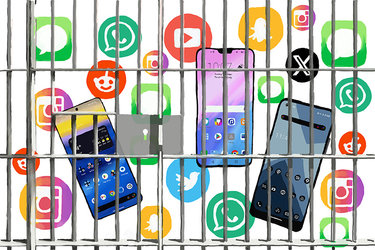Humans need to control tech tools not the other way around
It’s a paradox: Social media causes loneliness.
A technology that could easily connect one human being to another has had the effect of dividing and isolating us.
We wrote on this page last year about our nation’s top doctor, Surgeon General Vivek H. Murthy, and his advisory on a public health crisis: Loneliness.
The advisory charts the odds of premature mortality and concludes lacking social connection is as dangerous as smoking up to 15 cigarettes a day.
“Advisories,” Murthy’s report explains, “are reserved for significant public health challenges that require the nation’s immediate awareness and action.”
Our nation had never before been issued an advisory on loneliness.
The Centers for Disease Control and Prevention, based on data from 2021, reported that 42 percent of high school students felt so sad or hopeless almost every day for at least two weeks that they had stopped doing their usual activities.
Nearly three in five teenage girls felt persistently sad or hopeless, double the rate for boys, and a nearly 60-percent increase over the highest level recorded in the past decade.
It would be easy to see these findings as a result of the pandemic but, like loneliness, as Murthy’s advisory shows, the trends may have been made worse by the COVID-induced shutdowns and closures but they predated the pandemic.
Loneliness is not only more dangerous than other public-health threats that we all recognize, it is also more prevalent. About 13 percent of adults in the United States are smokers, about 15 percent have diabetes, about 42 percent are obese — while about half of U.S. adults report experiencing loneliness, with some of the highest rates among young adults.
Our governor, Kathy Hochul, was successful in passing legislation that is meant to curb addictive social media algorithms affecting the mental health of our youth and protect them from having their personal identifying information collected and sold.
Now the governor is focusing on the use of smartphones in school. She started a “listening tour” at Guilderland High School last month and is continuing in other venues across the state.
“I am the first mom Governor of New York,” said Hochul at a press conference after the Guilderland confab. “I’m hardwired to worry about our children and their safety, of course. But it’s also impossible to ignore the reality that this generation more than others is being subjected to distractions that never existed the way they are now.”
The president of NYSUT attended the Guilderland session as did two local Assembly members and Albany’s mayor along with local educators.
Guilderland Superintendent Marie Wiles unpacked for The Enterprise some of what was said at the session.
“She took a lot of notes,” said Wiles of Hochul, “and said she appreciated the candor.”
David Blanchard, superintendent of the rural Schoharie district, which two years ago instituted a policy where smartphones are not allowed at school, said initially parents were worried about not being able to reach their children, especially if there were a crisis, but everyone adjusted.
“He called it an unmitigated success,” Wiles reported, with students being more engaged with each other and with their classwork and fewer disciplinary issues.
Guilderland High School Principal Michael Piscitelli spoke of the way videotaping arguments or fights makes them linger, taking on a life of their own as they are shared on social media.
“It does heighten and extend incidents that happen in every high school and middle school,” said Wiles. “We struggle with it.” She noted that adolescent brains “are not built for restraint and reflection.”
Guilderland’s current policy is that students should not use phones during instructional times. They can use them while passing between classes, in study halls, and on lunch breaks.
Every Guilderland student has a Chromebook with access to the internet and half of the classrooms have Promethean boards. “The smartphone conversation,” Wiles stressed, “is not about what they can do for teaching and learning but rather the distractions they can pose.”
A Pew Research Center poll cited by the governor found that 72 percent of high-school teachers, 33 percent of middle-school teachers, and 6 percent of elementary school teachers say that students being distracted by cellphones is a major problem in their classrooms.
While over 80 percent of teachers say their school has a cell-phone policy, 30 percent say the policies are very or somewhat difficult to enforce, the poll found.
At the same time, seven in 10 teenagers ages 13 to 17 say there are generally more benefits than harms to people their age using smartphones, and 45 percent say smartphones make it easier for people their age to do well in school while another 30 percent say smartphones don’t affect teens’ success in school.
The discrepancy between younger and older New Yorkers on the issue is also evident in the results of a Siena poll released this week. New Yorkers over 35 support banning smartphones in classrooms 2-to-1 while voters under 35 support such a ban only by 44 to 40 percent.
So how frequently do teens use their phones in school?
Last September, Common Sense Media, a not-for-profit that looks at media impacts, released a report, “Constant Companion: A Week in the Life of a Young Person’s Smartphone Use,” based on two-hundred 11- to 17-year-olds who were monitored for a week.
The teenagers received a median of 273 notifications a day, with nearly a quarter coming in during school hours. One in five students receives more than 500 notifications a day.
Ninety-seven percent used their phones at some point during the school day, for a median of 43 minutes, and students picked up their cellphones during the school day a median of 13 times, though some students reached for the phone more than 200 times during the school day, the study found.
The use of smartphones in school of course is not limited to New York or the United States; like social media, it is global.
The United Nations Educational, Scientific and Cultural Organization’s 2023 Global Education Monitoring Report calls for technology, including smartphones, to be used in class only when it supports learning.
The pandemic, writes Audrey Azoulay, UNESCO Director-General “highlighted a deep-rooted tendency to see technological solutions as a universal tool, suitable for all situations, an inevitable form of progress.”
However, she distinguishes between the tool and the solution, the means and the end, focusing on three popular misconceptions.
First, the promise of personalized learning: “Very often, this powerful hope leads us to forget the fundamental social and human dimension that lies at the heart of education. It is worth reiterating the obvious: no screen can ever replace the humanity of a teacher,” Azoulay writes.
Second, while technology promises easier access to education, the reality is that digital divides still exist, to the point of actually increasing educational inequalities.
Third, despite the desire to make education a global common good, the role of commercial and private interests in education continues to grow, with all the ambiguities that entails. “To date, only one in seven countries legally guarantees the privacy of educational data,” Azoulay writes.
The UNESCO report makes two strong recommendations, meant to serve as a compass: It recommends that the best interests of pupils should systematically take precedence over any other and it recommends that technology should be seen as a means, never an end.
On smartphones, the UNESCO report cites one study looking at pre-primary through to higher education in 14 countries, which found smartphones distracted students from learning; even just having a mobile phone nearby with notifications coming through is enough to result in students losing their attention from the task at hand. Another study found that it can take students up to 20 minutes to refocus on what they were learning once distracted.
Removing smartphones from schools in Belgium, Spain, and the United Kingdom was found to improve learning outcomes, according to a study cited in the UNESCO report, especially for students that were not performing as well as their peers.
Syrian refugee children in Jordan improved foundational literacy by playing smartphone games while children with disabilities in Kenya were helped by smartphones, the report said.
Bans are more common in Asia. Both Bangladesh and Singapore ban smartphone use in class, but not in school. France bans smartphone use unless strictly for pedagogical purposes or to support children with disabilities.
The UNESCO report also makes this point: Students need to learn the risks and opportunities that come with technology and not be shielded from them entirely.
So where does that leave our local school district?
Superintendent Wiles said the school board will discuss the governor’s visit at its next meeting on Aug. 13. “I’m sure that will spark conversation among our board members about what we think is best for our community,” she said.
Wiles is currently reading Jonathan Haidt’s best-selling new book, “The Anxious Generation: How the Great Rewiring of Childhood Is Causing an Epidemic of Mental Illness.”
A social psychologist, Haidt argues that the combined trends of over-protecting children in the real world and under-protecting children in the virtual world have led to the current crisis. He recommends as an essential first step banning smartphones in schools.
Wiles said she is pleased she grew up in an era where she could play on her own with friends, no questions asked, as long as she was home by dinnertime.
We’re pleased the school board will discuss the use of smartphones. We think a school policy is better than a legislated state directive.
Asked about this, Wiles said, “I would prefer that we arrive at a decision like we arrive at most decisions, which is by engaging our community, getting feedback, providing information and insight, and then moving forward rather than, ‘Well, we have to do it.’”
That makes sense because, if a school policy is going to work, the students, parents, teachers, and other staff have to be in support of it.
In the Pew survey from which the governor cites the figure that 72 percent of high school teachers find smartphones a distraction, we note that about the same percentage of teens say there is more benefit than harm in using smartphones and 75 percent say either smartphones make it easier to do well in school or don’t affect school success.
We would posit that schools should be a place where students, starting at a young age, are taught how to use technology, including smartphones, in a way that is beneficial for them.
This technology isn’t going away; rather, it will continue to advance.
Why not work to educate our students to be responsible citizens in a digital age?
Wiles says the school district uses social media to amplify student voices and share student successes.
Rather than allowing smartphones to distract from learning, couldn’t teachers help their students understand how smartphones can help them learn, help them collaborate, and facilitate civic participation?
Wiles made a point in her June graduation speech about the value of civil conversation, where individuals take the time to listen, really listen to one another — not to respond or to make a point themselves.
She said this week, “With social media, students will post something and then some are — I could go so far as to say — addicted to see how many likes or shares they are going to get. They can get really sucked into defining self-worth through the number of likes … That’s like the recipe for self-doubt.”
If Haidt’s point is true, that kids today are under such strict parental control that they don’t learn how to control themselves or define themselves, isn’t it essential to teach them just that — how to find their own path?
As the United Nations report stressed: Students need to learn the risks and opportunities that come with technology and not be shielded from them entirely.


